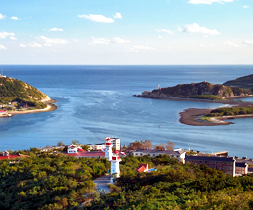Home> Attractions
Lushun Snake Museum
(chinadaily.com.cn) Updated: 2017-01-04
The Lushun Snake Museum is located in the Museum Park in Lushun Taiyang Valley Scenic Area. Occupying 14,000 square meters, 5,000 of which are under construction, it is the largest museum dedicated to snakes in Asia. The theme of the exhibitions is “returning to nature”; visitors are offered a new perspective on the island’s ecology. The museum includes sections for giant turtles, crocodiles, water snakes, poisonous snakes, pythons, giant salamanders, endangered animals, and marine reptiles. It also has a sample display section and a general purpose hall. It is a large tourist location integrating tourism, environmental protection, and entertainment.
Founded in 1917, the Lushun Snake Museum is a city-level history and art museum. It was formerly the Guandong Prefecture Manchurian and Mongolian Product Museum. It was completed and opened in 1918 at the cost of 300,000 Japanese yen. The name has been changed several times. In 1945, the former Soviet Union gained control of the museum and changed its name to Lushun Eastern Culture Museum. In early 1951, the Soviet Union transferred control of the museum to the Chinese government. In 1955, the name was changed back into Lushun Museum. More than 100,000 level I and level II collection items are stored here, among them numerous valuable bronze wares, Xinjiang antiques, paintings, and ceramics. In particular, it has a collection of foreign antiques, which is not common among Chinese museums. One item in that collection is the only well-preserved Indian Gandhara stone sculpture in China.
The amusement activity Bathing Chinese Dragons is routinely performed in the museum.
At the end of the 1980s, the State Administration of Cultural Heritage as well as the provincial and city governments successively invested two million yuan to repair and expand the museum. In 1999-2000, the municipal government continued Lushun Museum reconstruction work. Thirty million yuan were invested in the overhaul and improvement of an anti-burglary alarm, fire alarm, and security facilities. The newly-built exhibition hall integrates central air conditioning and artificial lighting.
As an important window of social education and foreign exchange, this museum receives 200,000 visitors annually. In recent years, it has held six museum collection exhibitions outside China. High-level Party and State officials including Dong Biwu, Soong Ching-ling, Zhou Enlai, and GuoMoruo have visited the museum. On August 17, 1999, Chairman Jiang Zemin examined the museum’s painting collections.
Currently, the brand new Lushun Museum is attracting foreign and domestic visitors and guests for sightseeing and appreciation of its growing historic and artistic value.
